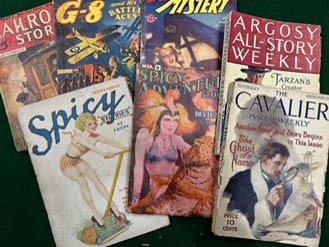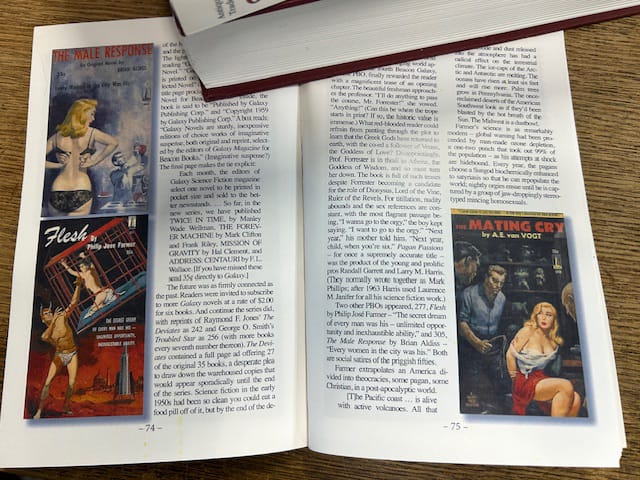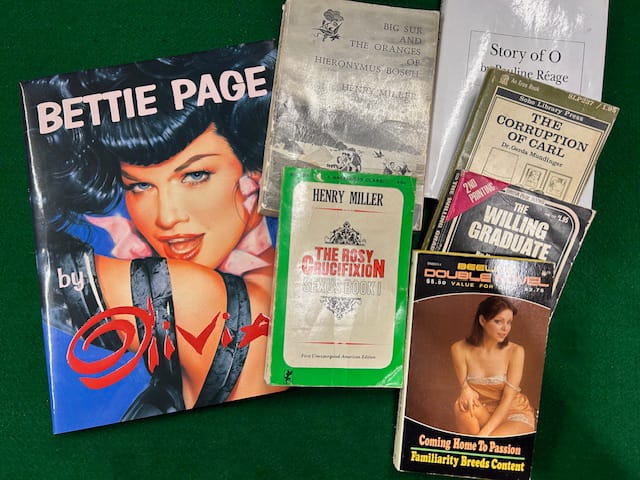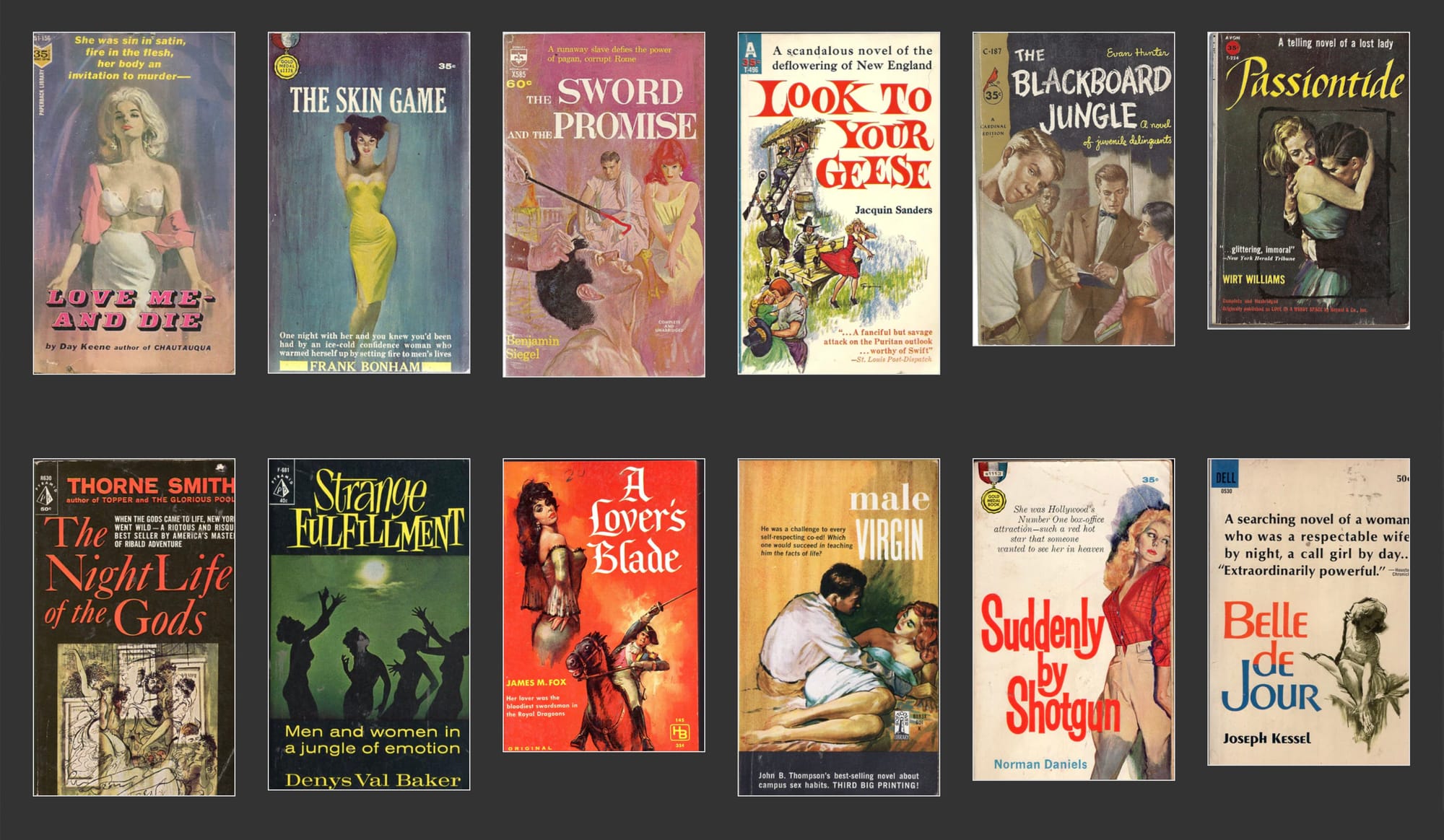Banning books and censorship have been issues since the beginning of book publishing. They often centered on ideas such as sex and violence that were found unacceptable by various groups of people. Obscenity has commonly been one of the prevalent reasons for banning books, although religion, politics, and philosophy were some of the main reasons books were censored in the early years. If you try to draw the line between risqué versus obscene, it can only be objective (people say they “know it when they see it”). The problem is, everyone has a different opinion on where to draw the line. Many assumptions regarding obscenity in the United States are definitions of ‘risqué’ and ‘obscene’ from the Victorian era, and those definitions are constantly changing. The ‘sleaze’ paperback of the 1960s transitioned from the Victorian attitude of obscenity to more of a contemporary attitude regarding topics such as sex and violence. Many science fiction, fantasy, and horror writers were involved in this transition, largely due to economic need.
In the 200 years from the 1700s to 1900s, the idea of banning books based on their so-called ‘obscene’ content became a major issue. Familiar examples of books banned in the United States include:• John Cleland, Memoirs of a Woman of Pleasure (Fanny Hill) published in 1749• Henry Fielding, The History of Tom Jones, a Foundling, published in 1749• Various books by the Marquis de Sade written in the late 1700s• D. H. Lawrence, Lady Chatterley’s Lover, published in 1928• James Joyce, Ulysses, published as a serial beginning in 1918• All of Henry Miller’s books, published in the 1930s to the 1960s

In the early 1900s, various pulp magazines like Snappy, Spicy Mystery, Speed Adventure Stories, Spicy Adventure Stories, Mystery Adventure Magazine, Yellow Book, Breezy, Spicy Western, Spicy Detective, Saucy Stories, Stage and Screen, New York Nights, Snappy Detective Stories, Bedtime Stories, Detective Stories, Tattle Tale, Pep Stories, Parisian Life and Captain Billy’s Whiz Bang treaded perilously close to the edge of what was considered to be ‘obscene’. (It is worth noting that a 1960s host on daytime television would read the material and jokes from magazines that others were calling “immoral” and “corrupt” on the air on TV.)
In the mid-1950s, Playboy began publishing. Then, in the 1960s, paperback books that were considered ‘pornographic’ were becoming more common. Today, we refer to these 1960s paperbacks as ‘sleaze’ — they would not currently be considered pornographic. They might fit in with the romance novel genre, or popular fiction (probably not very good popular fiction). However, the ‘60s sleaze’ genre became a major potential source of income for aspiring writers of the time.
The publishers of 1960s sleaze paid significantly better than most other publishers (around $500 to $800 per novel, sometimes with bonuses). The stories were formulaic and could be written quickly, and they were usually paid on acceptance of the manuscript. Typically, they were published under house names to preserve the anonymity of the authors. It was a time when sex was taboo and writing about it with too much realism, passion, or vivid description could get you sent to prison, so writers used innuendo and euphemism to tell their stories.

Around 1958, many of the science fiction, fantasy, and horror magazines began dying off, cutting off much of the market for their authors. As a result, a number of writers apparently began writing ‘60s sleaze’ novels to supplement their income. But because they were considered substandard by much of the population, writers tend to be reticent to acknowledge these publications.
There are reported to be a number of famous mystery writers who wrote 60s sleaze, but no one is able to identify with certainty who most of them are. However, there are those among famous science fiction, fantasy, and horror writers who have acknowledged that they wrote a number of 60s sleaze books. Robert Silverberg wrote about 150 60s sleaze novels from 1959 to 1964 that, at the time, were practically considered to be softcore porn (although today, people would be mostly indifferent to their content).
Some of the more famous science fiction, fantasy, and horror authors who penned 60s sleaze include:
- Robert Silverberg
- Harlan Ellison
- Andrew J. Offutt
- Bob Vardeman
- George Henry Smith
- C. M. Kornbluth
- Judith Merril
- Charles Nuetzel
- Bill Knowles
- Donal H, Gilmore
- Mike Resnick
- Donald Westlake
- Lawrence Block
- John Jakes
- Linda DuBreuil
- Marion Zimmer Bradley
- Jerome Murray
- Ed Wood
- Ron Haydock
- Richard E. Geis
- Orrie Hitt
- Donald Glut
- Harry Whittington
These authors and their pseudonyms were identified in various interviews and documented in books and magazines. They were involved in the transition in publishing from the Victorian sensibilities to the more open attitudes common now. Their 60s sleaze tends to be mostly implication and innuendo rather than explicit description — the language at the time avoided explicit or detailed descriptions. Even so, owing partly to their broad popularity, many of these books were part of the legal censorship activities in the 1960s.
In fact, a strange phenomena occurred during the 60s sleaze period: one of the 60s sleaze publishers Beacon Books, bought the Galaxy Novel science fiction publishing series from Galaxy Publishing in 1959. They then continued publishing this series under their format and numbering system. In some cases, they would insert a few pages of risqué material to spice up the story. For example, they added a two-page mining camp brothel scene on Mars to Cyril Judd’s Sin in Space (originally called Outpost Mars before this addition).

Although the content of these books were basic science fiction novels, and far from pornographic (even for the 1960s), starting with the third book of the Galaxy Novel series, the publisher revised the plots and titles to make the stories fit better into the 60s sleaze books inventory their audience was expecting from them. So, in a way, the 60s was a time of reverse censorship.
The idea of censorship seems to largely be based on the definition of obscenity, which evolves as we move through time. Much of what was once considered risqué (or even pornographic) is now considered to be socially acceptable. There was a seminal change of the laws in the 1950s and 1960s with various court cases addressing censorship. The 60s sleaze genre seemed to be emblematic of this transition, since it always rode the line between risqué and obscene. The question is, did the open attitudes of the science fiction, fantasy, and horror writers help in making this transition? It is a matter of open conjecture.
References:
• The Science-Fiction Collector, No. 4, 1977.• The Science-Fiction Collector, No. 5, 1977.• The Science-Fiction Collector, No. 8, 1979.• Megavore, The Journal of Popular Fiction, No. 13, 1981.• Daley, Astrid, and Adam Parfrey, Sin-A-Rama, Sleaze Sex Paperbacks of the Sixties, Feral House, 2016.• Hawks, Pat, Hawk’s Author’s Pseudonyms II, 1995.• McClellan, Grant S, Censorship in the United States, The Reference Shelf, Vol. 39 # 3, H. W. Wilson Co, 1967.• Wikipedia.
Steven Woolfolk is the owner of Xenophile Bibliopole & Armorer, Chronopolis Xenophilebooks.com

